The Georgia Rugby Union has been in existence since 1961, initially as a domestic union within the Soviet Union, and after independence, a national union and a member of the International Rugby Board.
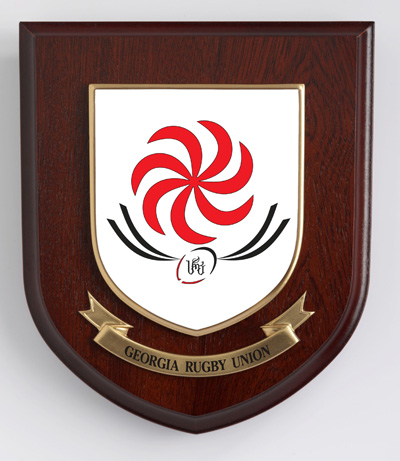
Georgia Rugby Union
Rugby gained popularity in Georgia when Jacques Haspekian from Marseilles started teaching rugby to students in the late 1950s.
He was interviewed in 2007 when Georgia played France in the 2007 Rugby World Cup.
By 1961 there was enough interest I rugby to form a three team domestic competition – the Tbilisi Championship. By 1964 the Tbilisi Rugby Section had grown to become the Georgia Rugby Federation, and functioned as a regional body within the USSR, although half of all Soviet rugby clubs were in Georgia.
A year after admission to the IRB, Georgia played their first international match against Zimbabwe, which they won 16 – 3.
I was surprised to discover that rugby union is one of the most popular sports in Georgia, in fact even more popular than football in the south of the country, and Georgian Rugby draws huge crowds – over 65,000 to watch Georgia play Russia in the European Nations Cup.
Because Georgia is a member of the Council of Europe, Georgian rugby players are eligible to play rugby in France. This has allowed many of Georgia’s top rugby players to play for French clubs.
The Georgian national rugby team is affectionately known as the “Lelos” ( “Lelo” is also the Georgian term for a “try”) – originally a traditional Georgian sport not dissimilar to Rugby Union. The Lelos qualified for their first Rugby World Cup in 2003, and qualified again in 2007 and 2011.
Play-offs in November 2013 will decide their fate for the 2015 Rugby World Cup.
Rowan Displays are proud of their Sports Shields and Plaques and were pleased to have won the contract to produce plaques for the Georgia Rugby Union, and look forward to seeing the team in action at the Rugby World Cup in the UK in 2015.
We’re always interested in the origins of any plaques we produce, even those as instantly recognizable as the Welsh Rugby Union.
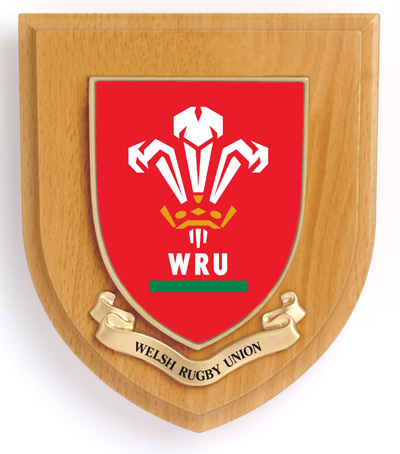
Welsh Rugby Union
They have a very comprehensive page about their fascinating history on their website at www.wru.co.uk/eng/thewru/history/brief_history.php
We were interested to note that the crest used by the Welsh Rugby Union is based on the “The Prince of Wales’s feathers” which is the coat of arms of HRH The Prince of Wales.
The original crest is made up of three white feathers rising from a gold crown, although the WRU changed the design slightly in the 1990s. This was done partly in order to copyright the design, and partly to modernise the design and make it more recognisable as exclusively WRU. The original Coat of Arms include the motto “Ich Dien” which has been replaced in the WRU badge with simply “WRU”.
The original design has raised some controversy over the years with suggestions that it was more symbolic of British monarchy than Welsh Rugby.
Hopefully this is no longer the case, although whatever badge you attach to it there is no denying the Welsh Rugby Union is a much loved and well respected part of Welsh life.

Cranfield University
Another order below which was despatched yesterday. I have attached the colour visual. Here is the link showing our shield in Cranfield Universities online shop http://shop.mycsa.org.uk/?page_id=1048
Cranfield University is a British postgraduate and research-based university with two campuses. The main campus is at Cranfield, Bedfordshire and the second is the Defence Academy of the United Kingdom at Shrivenham, Oxfordshire. The main campus is unique in the United Kingdom for having an operational airport (Cranfield Airport) next to the main campus. The airport facilities are used by Cranfield University’s own aircraft in the course of aerospace teaching and research.
The College of Aeronautics opened in 1946 on the former Royal Air Force base of RAF Cranfield[, and in 1969 became the Cranfield Institute of Technology which in turn becam Cranfield University in 1993.
The Coat of Arms of Cranfield University combines two cranes, alluding to the University’s name, derived from “Cranuc-feld” meaning a field frequented by Cranes. The three-branched torch in the base refers to learning and knowledge in the sciences of Engineering, Technology and Management, while the Astral Crown in the cres signifies the College of Aeronautics. The Keys signify the gaining of knowledge by study and instruction, and the outstretched wings of the Owl represent knowledge in the widest sense.
The motto, ‘post nubes lux’, means ‘out of darkness, light’.

London Scottish Bowling Association
We’ve recently had the privilege of making a number of embossed shields for the London Scottish Bowling Association.
The original artwork was redrawn by us to improve upon the old shields, and then the new embossed shields were produced.
It was an interesting project and I became curious about the origins of this well-established club. What a fascinating history!
The London Scottish Bowling Association was formed on 2nd December 1919.
It originated from a conversation between two Scots bowlers at the end of the Rosebery Cup at the Bellingham Bowling Club in 1919. Mr. William Taylor, a famous Dulwich skip, asked fellow Scot, Jimmie Duff, if he had ever thought of forming a Scottish Association.
Mr. Duff had already discussed the possibility with another Belmont member Mr. James Manson, the literary correspondent for the London and Southern Counties Bowling Association as well as bowls reporter to one of the Scottish papers in London. Mr. Mason was a keen bowler and also the author of “The Complete Bowler”.
These two gentlemen then contacted Mr. J Grant, who played then for Mid-Surrey, and agreed a meeting at Mr. Grant’s office to which a handful of other Scottish Bowlers were invited.
These pioneers included Messrs James Duff, James Manson, J O Grant, W Taylor, D B McBride, Tom Robertson and A Adamson. James Manson presided over these initial meetings which culminated in the The first General Meeting of the London Scottish Bowling Association at the Royal Scottish Corporation Hall on December 2nd 1919.
42 notable Scottish Bowlers applauded the birth of the Association and its mission to cultivate and maintain ties of friendship with “brither” bowlers from the Homeland.
James H. Duff was elected first President of the Association, a position he held for 4 years. Mr. Duff is recognized as a charming and enthusiastic man who was instrumental in laying the foundations for both the domestic functions and the tours of the London Scottish Bowling Association in London and Scotland.
Mr. Duff was highly respected in bowling circles and can even claim to have drawn up the rules that govern the English Bowling Association. The Scottish Bowling Association had, years before, tasked him to draw up a set of rules to cover the game of bowls. These same rules were adopted by the London and Southern Counties Bowling Association upon their founding in 1895 and then accepted and adopted by the English Bowling Association upon their founding in 1903.
In honour of Mr. Duff and his contribution to The London Scottish Bowling Association, the Association adopted the MacDuff tartan as the colors of the tie to be worn by members when playing Association matches.
Although London Scottish does not have a green of its own, it has been fortunate enough to have been offered the use of greens by a variety of clubs. The Association is also pleased to have hosted teams from across the world, including South Africa, New Zealand and the USA. The London Scottish Bowling Association has also played its part in the development of Indoor Bowls and has seen the winter fixture list grow steadily.
The Association is a friendly one, and apart from bowling hosts social events where members – old and new – can get together.
London Scottish Bowling Association is a proud and highly respected part of bowling and of London, and it has been a privilege for Rowan Displays to have worked with them
 Rowan Displays are proud to have been asked to produce one hundred shields and plaques for the RAF Aeronautical Rescue Co-ordination Centre (ARCC).
Rowan Displays are proud to have been asked to produce one hundred shields and plaques for the RAF Aeronautical Rescue Co-ordination Centre (ARCC).
The RAF Search and Rescue Force was created back in 1941 when there was a need to rescue crew from ditched aircraft during the war. By the end of the Second World War it had rescued over 12 000 people, military and civilian.There were originally two control centres, in Plymouth and in Edinburgh, but these were merged in 1997 into the current centre at RAF Kinloss in Moray.
The control centre is staffed by military personnel and civilians, and is responsible for coordinating search and rescue mission throughout the UK, and a large area of the North Atlantic sea. ARCC co-ordinates the RAF, Royal Navy and Maritime and Coastguard Agency Search and Rescue (SAR) helicopters, and also the Royal Air Force Mountain Rescue Service.
It was originally set up to provide assistance to military personnel but in the 21st century most the requests for assistance come from the Maritime and Coastguard Agency, Police, Ambulance services, and also Air Traffic Control organisations. Apart form helicopter searches ARCC also co-ordinates overland searches and communication between ambulances, hospitals and other emergency aircraft. It monitors rescues throughout the UK and a large part of the North Atlantic sea. ARCC receives over 3600 requests for assistance every year, and offers direct assistance to over 2000 people.
ARCC also hosts the UK Cospas-Sarsat Mission Control Centre (UKMCC), which is the centre that detects emergency beacons for the UK.
The ARCC Coat of Arms bears the motto “Constant Endeavour”. This motto was conferred as a battle honour on Royal Air Force Coastal Command by the Air Council to mark all that its men and women did to secure the seas during in the Second World War.
A memorial, to ‘Constant Endeavour’ is in the South Cloister of Westminster Abbey. It is a relief carving in light grey Carrara marble and shows the sky and the sea separated by a curved horizon. It was unveiled by Her Majesty The Queen to “Recall with gratitude all who served with RAF Coastal Command and its successor formations, praising God for their resolve to defend these Islands.”
It is a fitting motto and Rowan Displays are very proud to have been selected to produce plaques featuring this motto and it’s coat of arms. We are also eternally graful to the people of ARCC who undetake this “Constant Endeavour” on our behalf.
This is a fascinating, and by no means simple process.
In England a coat of arms can only be granted by “The College of Arms” after a fairly detailed process
First a person or institution needs to petition for arms. If the Earl Marshal approves a petition he will issue his Warrant to the Kings of Arms allowing them to proceed with the grant. At this stage the designing of the arms will begin. The Kings of Arms have full discretion over the design of the armorial bearings they grant, but the wishes of the applicant are taken into account as fully as possible. Once the design has been agreed with the petitioner it is checked against all previous arms on record to ensure it is distinct and then submitted to the Kings of Arms for their approval it is signed and sealed by the Kings of Arms, and a copy of it painted and scrivened into the official College registers.
Everything you need to know about the process and some fascinating information about the College of Arms can be found on their website http://www.college-of-arms.gov.uk/

Loughborough University was granted a Royal Charter on 19 April 1966. The coat of arms granted by the College of Arms includes the official colour of the university, which is a shade of violet specifically called African Violet. The coat of arms was designed to include certain symbols with a relevance to the area and the university.
These include the cross of Offa of Mercia as a symbol of the greatest king of the ancient kingdom of Mercia (within whose borders Loughborough stands). Offa was responsible for the first major issues of gold coins in Britain.
Another noteable addition to the coat of arms is the peafowl take from the original coat of arms of the Duke of Rutland.
The motto on the coat of arms is veritate scientia labore, which translates to either “with truth, wisdom and labour”, or possibly, “with truth, knowledge and work.
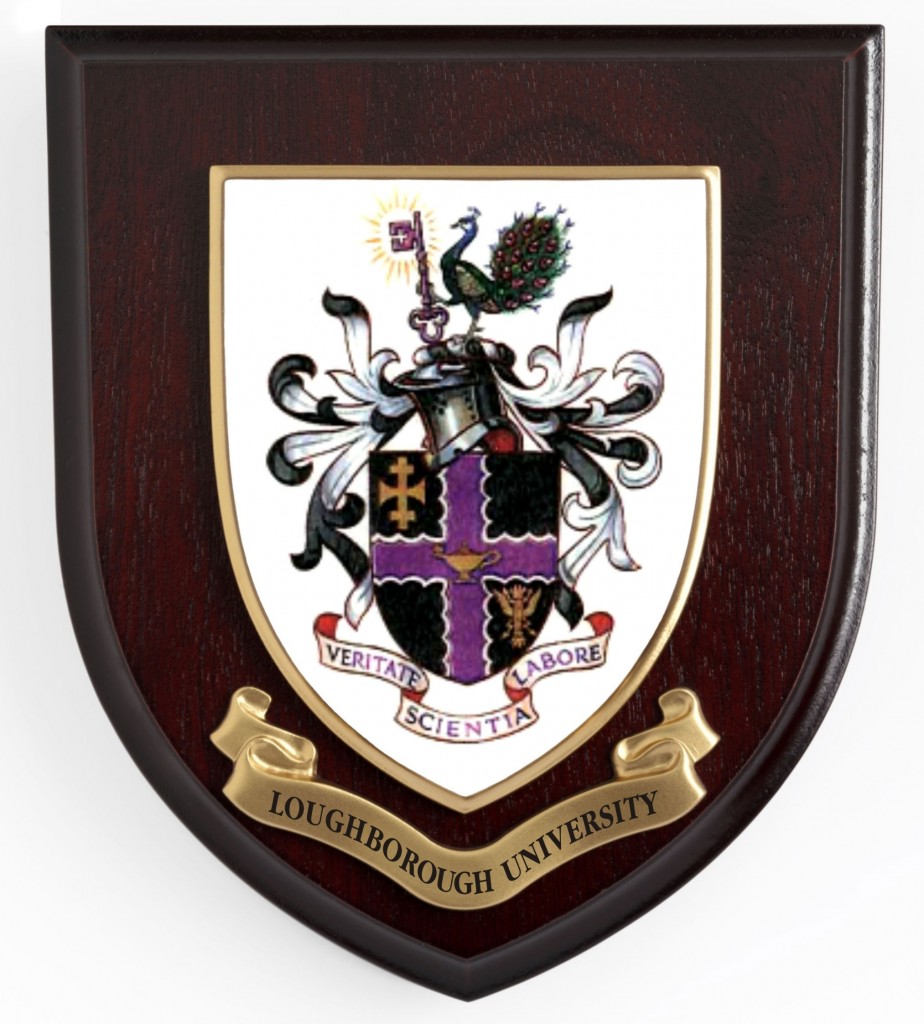
Either way it is an impressive and powerful coat of arms, although post London 2012 Olympics we wonder if it shouldn’t include those 5 rings. A coat of arms that is a source of pride to all of those that have a right to lay claim to it, and we are very proud of the reproduction on our plaques.
We have just added a blog to our website to keep you up to date with what we’re up to, and to share interesting, useful and exciting news that we come across.
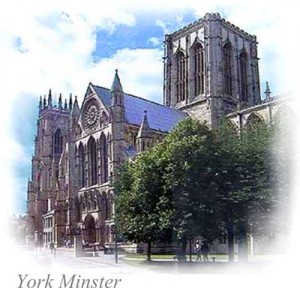
Situated in the heart of East Yorkshire and close to the historic city of York, we are a family run business with over 40 years of experience. Rowan has 3 websites for the 3 different areas of our business, although they do overlap and complement one another.
http://www.rowandisplays.com/ for Rowan Shields and Plaques
This is our first website, set up for the aspect of our business where we manufacture high quality, distinctive shields and plaques. Our clients include universities, schools, sports clubs, businesses and other organizations. Our plaques are used as sports awards, achievement awards, to mark milestones and as presentations.
http://www.rowandisplays.co.uk/ for Rowan Badges
We offer an extensive portfolio of badges and medals in a range of finishes and effects. Enamel and printed badges can be made up in any design and colour range – even 3D badges. This is also the place to go for keyrings, lanyards and other promotional gifts
http://www.rowan-printed-clothing.co.uk/ for printed clothing and workwear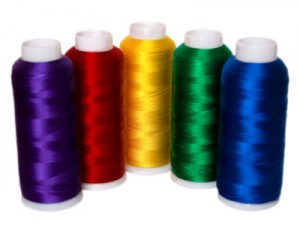
Our clothing site offers sports clothes, workwear and accessories for schools, businesses and sports clubs, and even fun clothing for stag and hen parties. Printed or embroidered clothing beautifully finished, and supplied quickly.
The people at Rowan are equally proud of all parts of this business, and we’d love to hear from you. If there’s anything you’d like to know, or anything you’d like us to know, get in touch – we’re friendly and we’d love to hear from you.